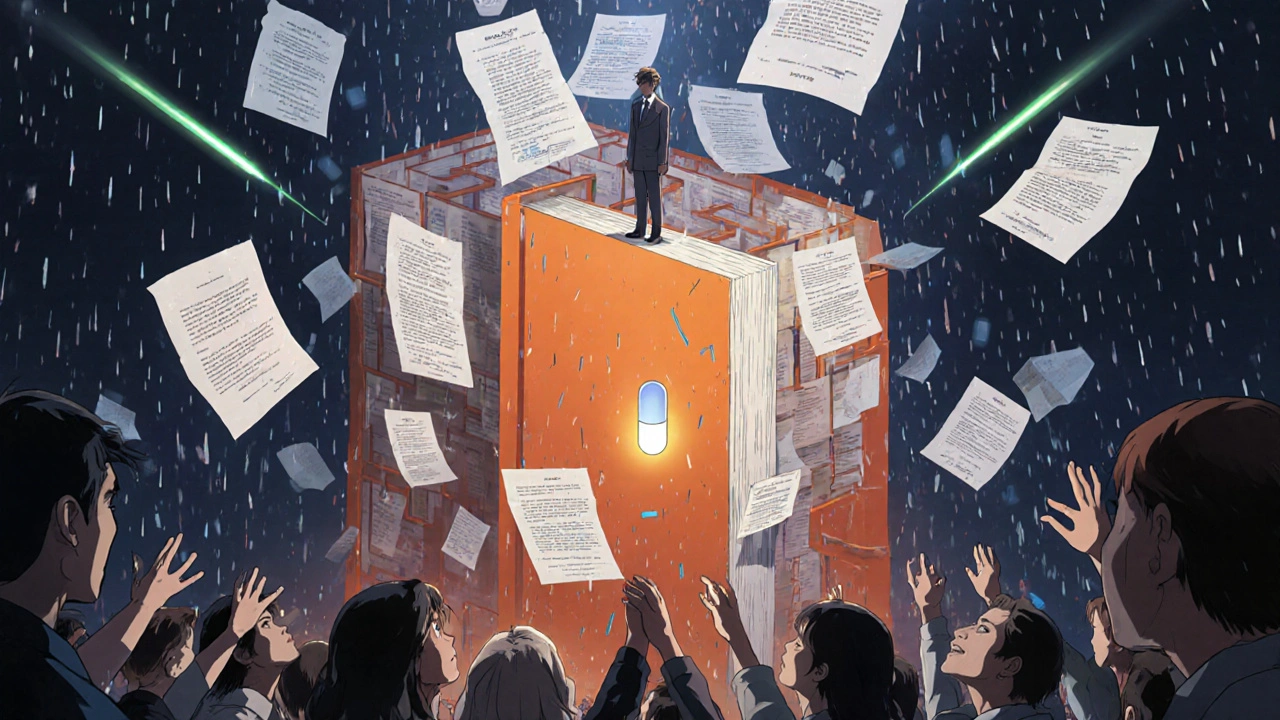When a brand-name drug’s patent runs out, generic versions should flood the market-lowering prices by 80% or more. But that doesn’t always happen. Behind the scenes, a complex web of court decisions, patent filings, and regulatory rules decides who gets to sell what, and when. These aren’t abstract legal debates. They directly affect whether you pay $5 or $500 for your insulin, blood pressure med, or cancer drug.
How Generic Drugs Fight for Access
The system that governs this battle was created in 1984 by the Hatch-Waxman Act. It was meant to be a compromise: give brand companies extra time to recoup R&D costs, while giving generic makers a clear path to enter the market. The key tool for generics? The Paragraph IV certification. When a generic company files an ANDA (Abbreviated New Drug Application), it can claim that a listed patent is invalid or won’t be infringed. That triggers a lawsuit from the brand company-and a 30-month clock that delays generic entry. But here’s the twist: if the generic is the first to file, it gets 180 days of exclusive market access. That’s a huge incentive. One company can make millions before anyone else joins. That’s why you’ll often see multiple generic makers rush to file on the same day. It’s not just about speed-it’s about winning the legal lottery.Amgen v. Sanofi: The Patent That Couldn’t Be Written
In 2023, the Supreme Court handed down a decision that changed everything for biologic drugs. Amgen held a patent covering millions of possible antibodies, but only showed how to make 26 of them. The court said: that’s not enough. You can’t claim the entire universe of a molecule just because you’ve made a few versions. This wasn’t just about Amgen. It was about every company trying to stretch a patent over broad scientific territory. The ruling made it harder to patent broad categories of biologics-like antibodies or gene therapies-without showing real, testable examples. For generic makers, this was a win. Suddenly, patents that looked bulletproof were vulnerable. For brand companies, it meant more risk and higher legal costs. Now, if you’re drafting a patent for a new antibody drug, you better have data for dozens of variants, not just one.Allergan v. Teva: The Patent Clock That Doesn’t Reset
In 2024, the Federal Circuit ruled in Allergan v. Teva that a later-filed patent can’t kill an earlier one-even if it expires sooner. Allergan had filed a patent on a drug formulation after Teva had already challenged the original patent. Allergan tried to use that later patent to restart the 30-month stay. The court said no. Once a patent is listed in the Orange Book and challenged, you can’t just file another one to reset the clock. This decision shut down a common trick used by brand companies: filing new patents on minor changes-like a different pill shape or coating-just to delay generics. That’s called “evergreening,” and courts are getting tougher on it. Now, companies can’t game the system by stacking patents. If your patent doesn’t cover the actual drug or its primary use, it won’t hold up in court.
Amarin v. Hikma: When Marketing Becomes Infringement
Here’s a sneaky one: you can infringe a patent even if you’re not making the exact same drug. In Amarin v. Hikma, the brand company sued because the generic’s label and marketing materials suggested the drug could be used for an unapproved purpose-something the brand’s patent covered. The court agreed. Even though Hikma’s label was technically “skinny”-meaning it only listed approved uses-the marketing brochures and sales reps hinted at off-label applications. That was enough to trigger induced infringement. This case scared generic makers. Now, they have to police not just their labels, but their entire marketing campaign. One email, one slide deck, one sales pitch-any suggestion of an unapproved use can open the door to a lawsuit.Orange Book: The Secret Database That Controls Drug Access
You’ve never heard of the Orange Book? You should. Officially called the “Approved Drug Products with Therapeutic Equivalence Evaluations,” it’s the FDA’s list of all patented drugs and the patents tied to them. Brand companies must list every patent that could block a generic within 30 days of getting approval. If they miss one, or list a patent that doesn’t actually cover the drug, the generic can sue them. In 2024, the FDA proposed new rules to crack down on improper listings. Companies were listing patents on manufacturing methods, packaging, or even delivery devices-things that had nothing to do with whether a generic could copy the drug. That’s called “patent thickets.” The new rules require companies to prove each listed patent directly relates to the drug’s active ingredient or approved use. If they can’t, the patent gets removed. That’s a big deal. One study found that 40% of Orange Book patents listed in 2023 were questionable at best.
Inter Partes Review: The New Weapon in Generic War Rooms
Before 2011, generic companies had only one path: federal court. Now, they have another: the Patent Trial and Appeal Board (PTAB). Through Inter Partes Review (IPR), they can challenge a patent’s validity without going to court. It’s faster, cheaper, and more predictable. In 2023, 78% of all generic patent challenges used IPR. Why? Because it’s a better shot at winning. Federal courts often side with patent holders. PTAB, however, has a 65% invalidation rate for challenged pharmaceutical patents. Generic makers now file IPRs before even submitting their ANDA. It’s become standard practice. If the PTAB kills the patent, the 30-month stay disappears. The generic can launch immediately.What’s Next? The Battle Isn’t Over
The legal landscape keeps shifting. The Supreme Court denied Amgen’s request for a rehearing in late 2024, meaning the strict enablement standard stands. The FDA’s new Orange Book rules are expected to take effect in 2025. And biosimilars-generic versions of complex biologic drugs-are exploding. In 2023, biosimilar cases made up 14% of all generic patent suits. By 2027, that number could hit 31%. But here’s the catch: every legal win for generics comes with a cost. Teva’s legal team says preparing for a single ANDA now costs $1.2 million more than it did five years ago. Why? Because they have to analyze every patent, file IPRs, draft skinny labels, and prepare for every possible legal twist. And patients? They’re caught in the middle. One Reddit user shared that their insulin alternative was delayed 22 months due to patent litigation. They paid $8,400 out of pocket. That’s not an outlier. Evaluate Pharma estimates $127 billion in generic sales are being held up by unresolved patent disputes through 2026.Why This Matters to You
This isn’t just about lawyers and drug companies. It’s about your wallet, your health, and your access to medicine. Every time a court says a patent is too broad, a generic can enter sooner. Every time a company is forced to remove a fake patent from the Orange Book, prices drop faster. Every time a generic wins an IPR, thousands of people get affordable meds. The system isn’t broken-it’s being manipulated. The law gives generics a path. But brand companies have spent decades building walls around it. The landmark cases we’ve seen since 2023 are starting to tear those walls down. Not completely. But enough to make a difference. If you’re paying for prescriptions, you’re already in this fight. The next time you see a generic drug hit the shelf sooner than expected-thank a court decision. And maybe, just maybe, thank the generic company that had the guts to challenge a billion-dollar patent.What is the Hatch-Waxman Act and how does it affect generic drugs?
The Hatch-Waxman Act of 1984 created a legal framework that lets generic drug makers get approval faster by relying on the brand company’s safety data. In return, it gives brand companies extra patent time to recover R&D costs. Generics can challenge patents using Paragraph IV certifications, which can trigger lawsuits and 30-month delays. But if they’re the first to file, they get 180 days of exclusive sales-a major financial incentive.
What is the Orange Book and why does it matter?
The Orange Book is the FDA’s official list of approved drugs and their associated patents. Brand companies must list every patent they believe blocks generic entry. If they list a patent that doesn’t actually cover the drug’s active ingredient or approved use, generics can challenge it. Courts and the FDA are now cracking down on improper listings, which have been used to delay competition.
What is a Paragraph IV certification?
A Paragraph IV certification is a legal statement a generic company makes when filing an ANDA. It says that a listed patent is either invalid or won’t be infringed by the generic product. This triggers a lawsuit from the brand company and starts a 30-month clock that delays generic approval. But if the generic wins the case or the patent is invalidated, they can launch immediately-and get 180 days of exclusivity if they were first to file.
How did Amgen v. Sanofi change biologic patents?
The Supreme Court ruled that a patent can’t claim millions of possible molecules if the inventor only shows how to make a handful. Amgen’s patent covered a broad range of antibodies but only provided 26 working examples. The court said that’s not enough to satisfy the legal requirement of “enablement.” This raised the bar for biologic patents, making it harder to patent broad categories without real, testable data.
What is an IPR and why do generic companies use it?
An Inter Partes Review (IPR) is a fast, cheaper way to challenge a patent’s validity at the Patent Trial and Appeal Board (PTAB). Unlike federal court, where patent holders win 70% of the time, the PTAB invalidates about 65% of challenged pharmaceutical patents. Since 2023, 78% of generic challengers use IPRs before or alongside court cases. It’s become a standard tool to knock out weak patents and clear the path for market entry.
Can a generic drug company be sued for marketing?
Yes. In Amarin v. Hikma, the court ruled that even if a generic’s label only lists approved uses, marketing materials that suggest off-label applications can lead to induced infringement claims. This means generic companies must now police every piece of promotional content-emails, slides, sales scripts-to avoid suggesting uses covered by brand patents. It’s turned marketing into a legal minefield.
Why are generic drug prices still high in some cases?
Even when patents expire, litigation delays can block generics for years. Companies use tactics like listing weak patents in the Orange Book, filing new patents for minor changes, or suing over marketing language. These delays cost patients billions. In 2024, the FTC said improper patent listings delay generic entry by an average of 1.5 years. That’s why court decisions like Amgen v. Sanofi and Allergan v. Teva are so important-they’re starting to close those loopholes.

Edward Batchelder
The Hatch-Waxman Act was supposed to be a fair balance, but over time, it’s become a loophole factory for big pharma. I’ve seen firsthand how a single patent filing can delay a generic by years-and that’s not justice, it’s exploitation. Patients shouldn’t have to choose between rent and insulin because of legal technicalities.
When the courts finally start enforcing the spirit of the law instead of the letter, we’ll see real change. Until then, every IPR filed by a generic company is a small act of resistance.
I’m not anti-patent-I’m pro-access. If you invent something, you deserve a return. But you don’t deserve to own the entire category of a molecule just because you made 26 versions.
The Amgen v. Sanofi ruling? That was the first real crack in the wall. And it’s about time.
Let’s not forget: the Orange Book isn’t just a list-it’s a weapon. And right now, it’s being used to choke competition.
Thank you for laying this out so clearly. This is the kind of transparency we need more of.